#COOPERMADE: The Posters
Tue, Aug 24, 2021 12am - Thu, Sep 9, 2021 12am

Photo by Marget Long / The Cooper Union
From August 24 through September 9, 2021 the West-facing colonnade windows of the Foundation Building contained a series of posters inspired by the impact of The Cooper Union's graduates on the world as part of a development campaign called #COOPERMADE. The text and posters can be seen below.
Though The Cooper Union is renowned as a leading school for architects, artists, and engineers, the achievements of our graduates reach far beyond their individual disciplines and professions. Cooper alumni have helped shape everyday life, popular culture, and the city we live in, in ways both instantly recognizable and extraordinary. This exhibition, #COOPERMADE, celebrates just a few of those contributions that were made possible by a Cooper education.
The accomplishments of our alumni are a testament to the values of the school’s founder, industrialist and philanthropist Peter Cooper (1791–1883), who dedicated his life to innovation. He developed the I-beam, using it as a support and fireproofing system for this very building in 1859, well before iron and steel were used for architectural structure; invented the “Tom Thumb,” an early steam locomotive; and was instrumental in the laying of the first trans-Atlantic cable lines for communication with Europe
The innovations we present in the following panels span a wide range of fields, but they all reflect Cooper’s influence on lifelong creativity and dedication to imagining new possibilities.

THE JELL-O IN YOUR KITCHEN
Peter Cooper | Founder
Peter Cooper, The Cooper Union’s founder, owned a factory that produced glue and gelatin from animal by-products. Cooper pioneered a method to produce powdered gelatin that could be packaged and sold to home cooks, securing a patent in 1845. He sold the powder with recipes that suggested adding sugar and fruit juice and setting the gelatin in decorative copper molds. In 1895, Cooper sold the patent to cough syrup manufacturer Pearle Wait, whose wife May named the product “Jell-O.”

PROVING EINSTEIN’S THEORY OF RELATIVITY
Russell Hulse | Physics 1970
A Nobel Prize in Physics—In 1974 at the Arecibo Observatory in Puerto Rico, Russell Hulse and his advisor Joseph Taylor Jr. discovered a binary pulsar, a celestial system in which two pulsars—magnetized, rotating stars—orbit one another. It proved to be a highly significant find: the binary pulsar provided what was then the only evidence confirming Einstein’s theory of gravitational waves. In 1993, Hulse and Taylor were awarded the Nobel Prize in Physics for their discovery.

FROM RICE BALLS TO GUM BALLS
Giulia Della Gatta | Art 1996
Arancini—a Sicilian street food of deep fried cheese and rice—is the star of Giulia Della Gatta’s business, Arancini Bros., which has concessions around the city. Besides the classics, they offer a French onion variety with gruyere cheese, an apple pie rice ball, and even Nutella-filled arancini. “Our varieties are pretty extensive and, logistically speaking, unheard of. The only food sector that comes close is ice cream or candy. It’s a unique position to hold.”
Eugene Jang | Chemical Engineering 2005
Eugene J. Candy Co. opened in March 2016 in Bushwick stocked with eclectic sweets engineered by its owner, Eugene J. “My customers are 20- and 30-year-old ‘kids.’ I see very few actual children.” His signature candy is FG. Freaks,™ a slightly sour, crunchy hard candy that he concocted over hundreds of hours of experimentation, drawing on his Cooper training as a chemical engineer. “Lab work is my approach. I systematically try things out, take notes like a lab report. One hundred recipes later, I’ll have a candy.”

YOUR DSL CONNECTION
Joseph Lechleider | Mechanical Engineering 1954
In the 1980s, the internet was in its infancy, and mainly used by large corporations and the military. Phone companies wanted to bring data services to homes, but there were several engineering challenges to overcome first. Sending data at the same speed in each direction created interference on the lines known as “electrical crosstalk” and made the system inoperable. Joe Lechleider solved the problem, realizing that making download speeds faster than upload speeds would reduce the electrical crosstalk: the Digital Subscriber Line (DSL) was born.

THE VOYAGER PROBE MISSION
Maxine Nietz | Civil Engineering 1976
Maxine Nietz served as a mission operations controller for NASA’s Jet Propulsion Lab, coordinating communications with the Pioneer, Helios, Viking, and Voyager probes, which have provided invaluable data about the solar system and beyond. “It’s 24-hours-a-day shift work, and I was the first woman ever to do that. And I guess the other controllers were flustered because after we set up our download of the Voyager, they called in and said, ‘Was that really a lady just now?’”
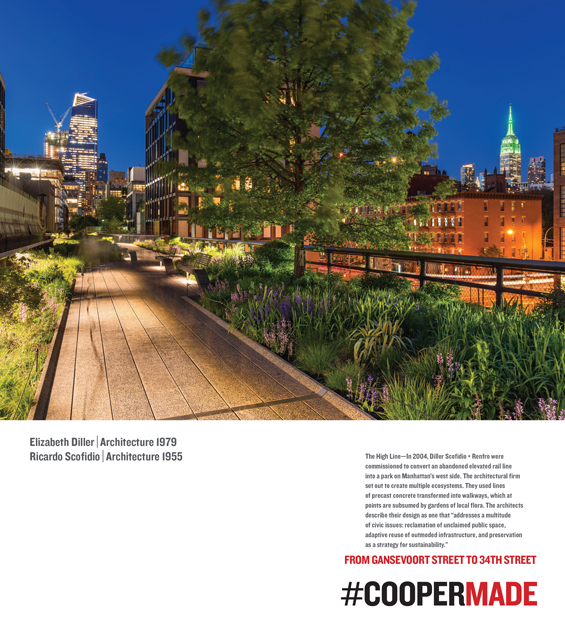
FROM GANSEVOORT STREET TO 34TH STREET
Elizabeth Diller | Architecture 1979
Ricardo Scofidio | Architecture 1955
The High Line—In 2004, Diller Scofidio + Renfro were commissioned to convert an abandoned elevated rail line into a park on Manhattan’s west side. The architectural firm set out to create multiple ecosystems. They used lines of precast concrete transformed into walkways, which at points are subsumed by gardens of local flora. The architects describe their design as one that “addresses a multitude of civic issues: reclamation of unclaimed public space, adaptive reuse of outmoded infrastructure, and preservation as a strategy for sustainability.”
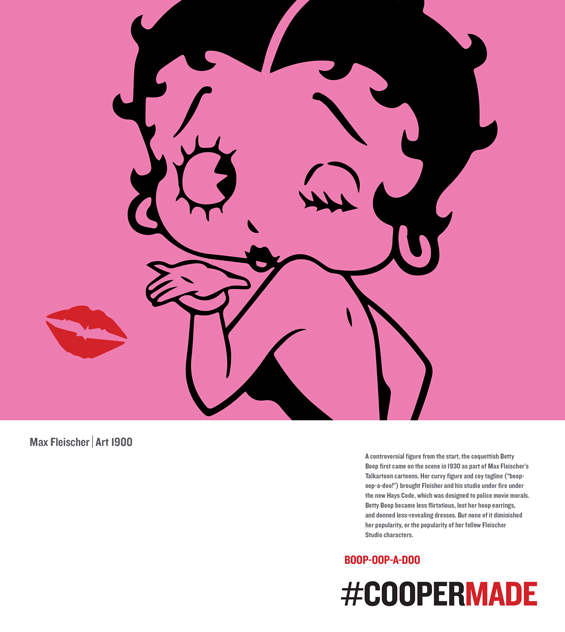
BOOP-OOP-A-DOO
Max Fleischer | Art 1900
A controversial figure from the start, the coquettish Betty Boop first came on the scene in 1930 as part of Max Fleischer’s Talkartoon cartoons. Her curvy figure and coy tagline (“boop-oop-a-doo!”) brought Fleisher and his studio under fire under the new Hays Code, which was designed to police movie morals. Betty Boop became less flirtatious, lost her hoop earrings, and donned less-revealing dresses. But none of it diminished her popularity, or the popularity of her fellow Fleischer Studio characters.

FROM COOPER SQUARE TO CENTRAL PARK
Augustus Saint-Gaudens | Art 1866
The name Augustus Saint-Gaudens is forever tied to the grandeur of late 19th century New York, where wealthy and powerful patrons frequently turned to the sculptor for the city’s most important commissions. He gained renown for his sculptures of Civil War heroes such as Admiral David Farragut and William Tecumseh Sherman. Saint-Gaudens’s sculpture of Peter Cooper in nearby Cooper Square is framed by a niche and pedestal by Stanford White, the great beaux arts architect.

THE SUPERHEROES
Patty Jenkins | Art 1993
Patty Jenkins came to Cooper to study painting and photography, but it was an experimental film class that brought her to filmmaking. After eight years as an Assistant Camera Person/Focus Puller on commercials and music videos, she wrote and directed her first feature film “Monster” (2003), starring Charlize Theron, but today is better known for her “Wonder Woman,” the 2017 blockbuster starring Gal Gadot. Jenkins will be the first woman to direct a “Star Wars” feature film; “Rogue Squadron” is expected in theaters in 2023.
Bob Kane | Art 1933
Bronx-native Bob Kane trained as an illustrator in the studio of another Cooper alumnus, Max Fleischer, before creating Gotham City’s own dark knight, Batman. The character was, in part, a result of Kane’s art training: he cited Leonardo da Vinci’s drawings of flying machines with bat wings as one of his inspirations. Kane, who was also a painter, continued to work on various Caped Crusader projects throughout his career, including newspaper comic strips and the wildly successful movie franchise.
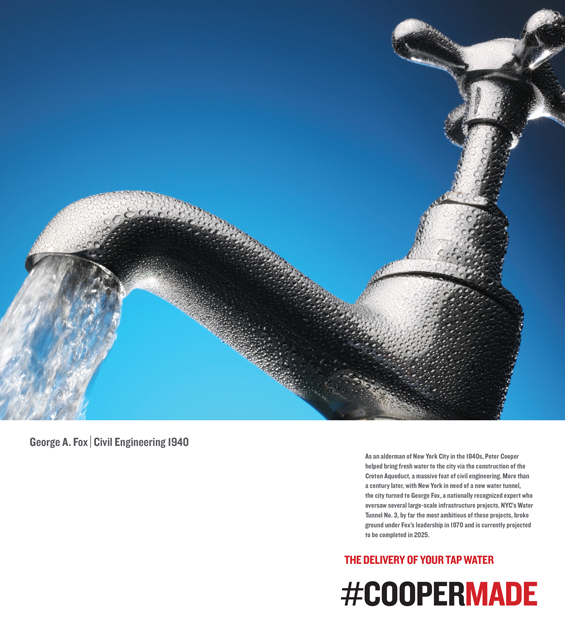
THE DELIVERY OF YOUR TAP WATER
George A. Fox | Civil Engineering 1940
As an alderman of New York City in the 1840s, Peter Cooper helped bring fresh water to the city via the construction of the Croton Aqueduct, a massive feat of civil engineering. More than a century later, with New York in need of a new water tunnel, the city turned to George Fox, a nationally recognized expert who oversaw several large-scale infrastructure projects. NYC’s Water Tunnel No. 3, by far the most ambitious of these projects, broke ground under Fox’s leadership in 1970 and is currently projected to be completed in 2025.
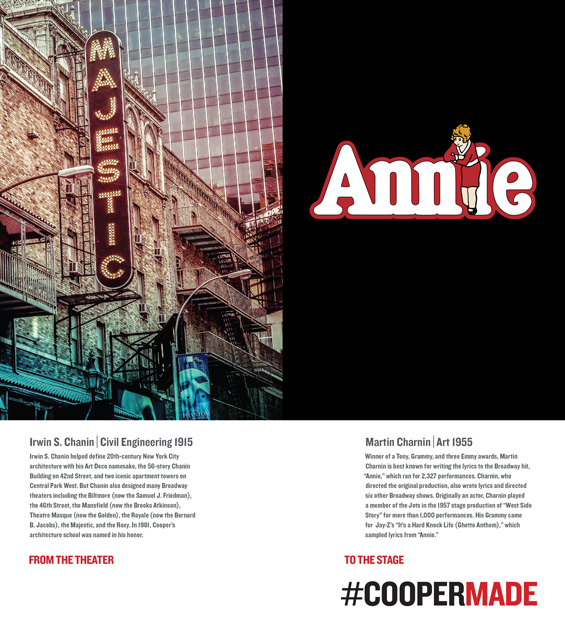
FROM THE THEATER TO THE STAGE
Irwin S. Chanin | Civil Engineering 1915
Irwin S. Chanin helped define 20th-century New York City architecture with his Art Deco namesake, the 56-story Chanin Building on 42nd Street, and two iconic apartment towers on Central Park West. But Chanin also designed many Broadway theaters including the Biltmore (now the Samuel J. Friedman), the 46th Street, the Mansfield (now the Brooks Atkinson), Theatre Masque (now the Golden), the Royale (now the Bernard B. Jacobs), the Majestic, and the Roxy. In 1981, Cooper’s architecture school was named in his honor.
Martin Charnin | Art 1955
Winner of a Tony, Grammy, and three Emmy awards, Martin Charnin is best known for writing the lyrics to the Broadway hit, “Annie,” which ran for 2,327 performances. Charnin, who directed the original production, also wrote lyrics and directed six other Broadway shows. Originally an actor, Charnin played a member of the Jets in the 1957 stage production of “West Side Story” for more than 1,000 performances. His Grammy came for Jay-Z’s “It’s a Hard Knock Life (Ghetto Anthem),” which sampled lyrics from “Annie.”
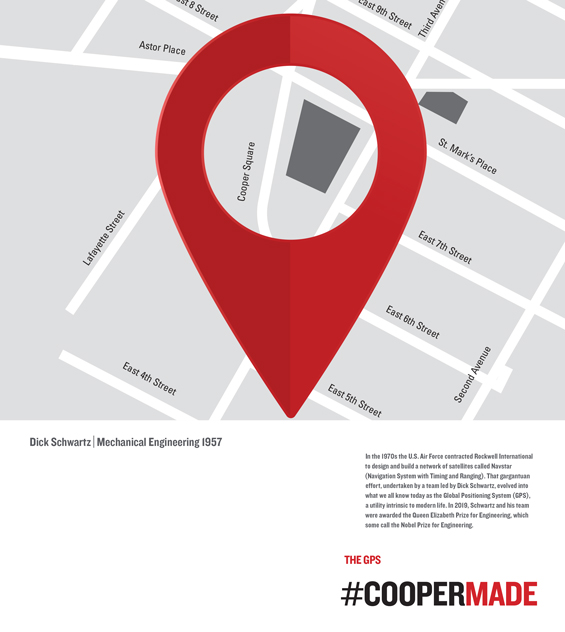
THE GPS
Dick Schwartz | Mechanical Engineering 1957
In the 1970s the U.S. Air Force contracted Rockwell International to design and build a network of satellites called Navstar (Navigation System with Timing and Ranging). That gargantuan effort, undertaken by a team led by Dick Schwartz, evolved into what we all know today as the Global Positioning System (GPS), a utility intrinsic to modern life. In 2019, Schwartz and his team were awarded the Queen Elizabeth Prize for Engineering, which some call the Nobel Prize for Engineering.
Located at 7 East 7th Street, between Third and Fourth Avenues




